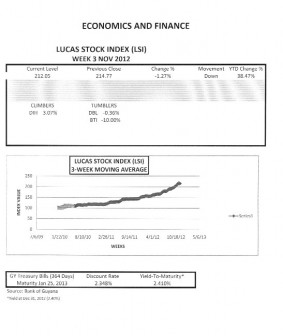Declining Participation
Unions in Guyana are not as strong as they used to be and many of the institutions that supported workers have either been weakened or otherwise undermined. The result of the labour movement being in disarray is reflected in the diminished growth in union membership and declining participation in labour events in the country. The ineffectiveness of unions is also seen in the protracted, and in some cases, unresolved disputes with employers. The important role that unions played in the creation and development of an independent Guyana and their value in improving workers’ rights and living conditions seem lost on an increasingly apathetic population. One cannot discount the deleterious impact that migration has had on the decline of the labour movement in Guyana, but the belief that unions were just there to fight colonial rule seems to have taken hold in Guyana. Yet, Guyana might have a labour problem that is in need of urgent attention.
Flaring up
Indeed, industrial disputes have been flaring up frequently in the sugar industry, except that those frequent work stoppages have not led to violent confrontation with the highly unprofessional and indisciplined Guyana Police Force. That some union leaders would bury their heads in the sand and claim that there was no corruption in the country is further evidence that some labour unions are no longer interested in fighting for workers and their rights. It is not easy to put a monetary value on corruption, but any resources lost to the economy results in the loss of an opportunity to expand aggregate income and increase compensation for all, including workers. It might not matter to some union bosses as well that valuable labour resources were being lost to the country with consequences for productivity and the retirement income of workers.
Endemic poverty

LUCAS STOCK INDEX
The Lucas Stock Index (LSI) declined by 1.27 per cent in the third week of trading in the month of November 2012. The decline resulted from a 10-per cent decline in the stock value of Guyana Bank for Trade and Industry (BTI) and a reversal of 0.36 per cent of the stock price of Demerara Bank Limited (DBL). The positive movement of 3.07 per cent in the stock price of Banks DIH (DIH) was insufficient to curb the decline that also caused the LSI to drop below the 40 percentage point advantage over the yield of the 364-day Treasury Bills that the index enjoyed last week.
The labour situation is one that requires careful study and needs to be addressed as a matter of concern, if not priority. A new population census is underway and that exercise should capture much data about life and living conditions of Guyanese. The conclusion of the census and the timely publication of its results should provide Guyanese with some hard data with which to work to draw firm conclusions about the condition of workers in the country. Census results would also help with a study of how to improve conditions for workers if necessary. In the meanwhile, one has to rely on existing published data to extrapolate about the condition of workers in Guyana. For example, data reported in the annual budget speeches to Parliament offer evidence that between 30 to 35 per cent of workers are earning minimum wage. Also, the 2002 Census showed Region 10 with an unemployment rate of over 15 per cent well above the national average which at the time was 12 per cent. In the lead up to the recent crisis in Linden that exposed how endemic poverty was in that community, an unemployment rate, well above that shown in the 2002 data, was frequently being quoted. The 2012 Census remains very important and the exercise should be supported by households.
Stagnant
A preliminary examination of public data reveals that employees are working hard, but one cannot be sure if they are receiving the rewards and recognition that should come with the effort being made. To appreciate the effort being made by Guyanese workers, it is useful to take a good look at what the economic performance of the country was in recent times. The economy has grown by an average of four per cent over the last six years. Despite this growth, the share of compensation going to workers remains stagnant at around 37 per cent of gross domestic product (GDP). In other words, the compensation that employees receive from employers represents a bit more than one-third the value that was added to output by businesses in Guyana each of the last six years. Experts point out that the share of labour cost in total product costs reflects the skill level of labour in a country. A low share of wages represents a high input of unskilled work in the product.
Tightening market
Another important metric in assessing the condition of workers in the economy is the unit labour cost. This gives an indication of how fast wages are rising versus the rate at which output is expanding. Over the last six years, the unit labour cost was projected to have risen by about eight per cent. Unit labour costs reflect worker productivity and changes in wages. The nominal wages of workers rose an average of 12 percent in the last six years while productivity increased by four percent. A relatively high increase in unit labour costs of eight per cent is typical of a tightening labour market where companies are forced to increase wages to keep good workers and are also forced to employ lower skilled workers. Based on the foregoing, the increase in the unit labour is a reflection of wage inflation and lower productivity, a consequence of having to depend on lower-skilled workers. Instead of becoming more efficient, employers in Guyana are likely becoming more desperate. Despite these favourable conditions for labour, some unions in Guyana remain powerless.
Surging production
Admittedly, it is not clear where in the economy the wage increases might be taking place. One could only assume that migration and the lucrative incomes from the gold fields are putting pressure on the labour market. According to the 2002 Census, the distribution of labour in the economy was skewed towards industries in agriculture and the distributive trade. At an early stage, construction made a play for labour in the economy. Of late the extractive industries have been surging in production. The stubbornly high global gold prices have attracted substantial investment into that industry within the last three years. Bauxite production has also made a surge while oil and manganese exploration have intensified during the same period.
In the absence of hard evidence, no one could be sure where the wage increases are taking place. But given the increased demand for resources in the extractive industries, the observed wage inflation might be concentrated in the mining sector. Despite the growth in the mining sector, unions do not seem well positioned to take advantage of the growth in labour participation in the mining sector.







